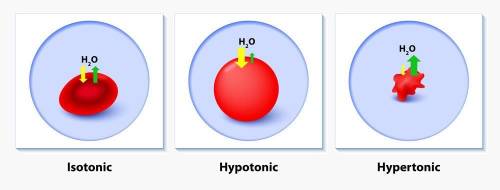
Students used eggs to observe the effect of osmosis on cells. in the experiment, the egg represented a typical cell. before beginning the experiment, students soaked the raw eggs overnight in vinegar to remove the shells. after the shells were removed, students obtained the mass of the shell-less eggs. students then soaked the eggs in a variety of solutions: vinegar, 10% salt water, corn syrup (kayro), and distilled water. after 24 hours, the eggs were removed from their respective solutions, dried off, and massed. the results are recorded in the data table provided. based on the results, what type of solution is the salt water? a) the salt water is hypotonic because it has less solutes than the egg. b) the salt water is isotonic because there is no mass change in the egg. c) the salt water is hypertonic because it has more solutes than the egg. d) the salt water is hypertonic because there is no mass change in the egg.

Answers: 2


Another question on Biology

Biology, 21.06.2019 19:40
Populations of blue-winged warblers, a type of bird, migrate south in the winter and return to canadian breeding grounds in the spring. as global temperatures have increased due to climate change, spring has started arriving in the warbler's breeding grounds earlier in the year, before the warblers return. warblers now arrive at their breeding grounds too late to select ideal nesting sites and to feed on important early-spring food sources how are populations of blue-winged warblers most likely to be affected by the earlier arrival of spring? o a. populations will go extinct since the warblers will stop migrating to breeding grounds. b. populations will be unaffected since most species can quickly adapt to effects of climate change. c. populations will increase since warmer temperatures are generally beneficial to survival, d. populations will decline since individuals will be less likely to successfully reproduce, reset next
Answers: 1

Biology, 22.06.2019 02:00
Bisphenol a (often called bpa) is a chemical found in products that people use every day, from water bottles to food containers to children's toys. unfortunately, bpa leaches out of its many products and makes its way into our bodies. what are the health effects of bpa exposure? ongoing research is finding that elevated exposure to bpa can affect a wide variety of developmental and physiological processes, but one of the first studies of bpa's health effects came about because of a simple mistake in the lab. at a laboratory at case western reserve university in 1998, geneticist patricia hunt was making a routine check of her female lab mice. as she extracted and examined developing eggs from the ovaries, she began to wonder what had gone wrong. she noticed that many of the eggs showed problems with their chromosomes, and some had irregular amounts of genetic material, which can lead to miscarriages and birth defects in mammals. she learned that a lab assistant had mistakenly washed the plastic mouse cages and water bottles with a harsh soap, releasing bpa from the plastic. knowing that bpa is an endocrine disruptor, a chemical that can enter organisms and mimic hormones, hunt set out to discover whether it had adversely affected her mice.
Answers: 2


Biology, 22.06.2019 21:00
Do plants make food in their stems flowers roots or leaves?
Answers: 2
You know the right answer?
Students used eggs to observe the effect of osmosis on cells. in the experiment, the egg represented...
Questions




Computers and Technology, 01.06.2021 21:10


French, 01.06.2021 21:10

Mathematics, 01.06.2021 21:10



Mathematics, 01.06.2021 21:10

Mathematics, 01.06.2021 21:10

English, 01.06.2021 21:10

Mathematics, 01.06.2021 21:10

Mathematics, 01.06.2021 21:10


Mathematics, 01.06.2021 21:10

Mathematics, 01.06.2021 21:10

Mathematics, 01.06.2021 21:10

Physics, 01.06.2021 21:10

Biology, 01.06.2021 21:10




